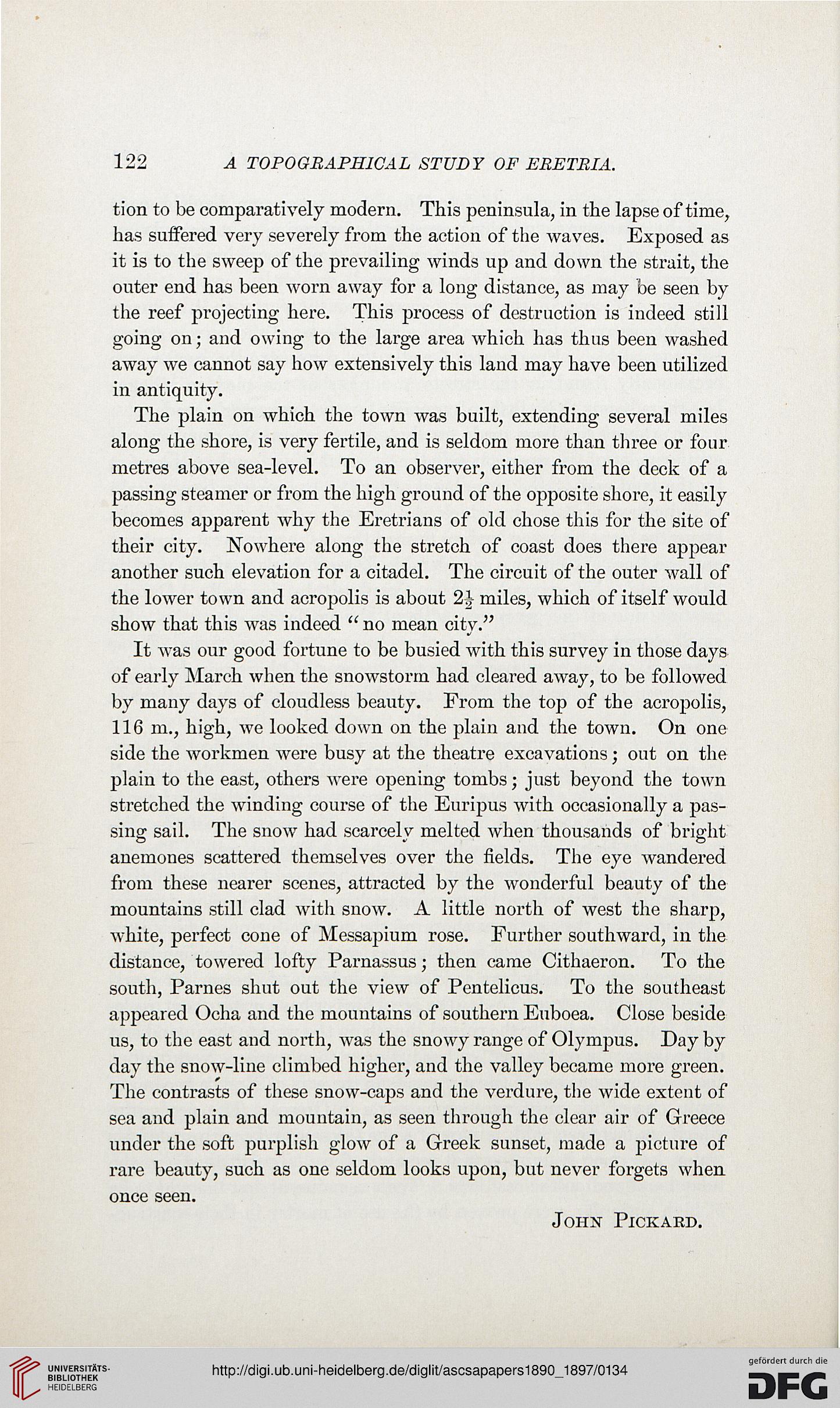122 A TOPOGRAPHICAL STUDY OF ERETRIA.
tion to be comparatively modern. This peninsula, in the lapse of time,
has suffered very severely from the action of the waves. Exposed as
it is to the sweep of the prevailing winds up and down the strait, the
outer end has been worn away for a long distance, as may be seen by
the reef projecting here. This process of destruction is indeed still
going on; and owing to the large area which has thus been washed
away we cannot say how extensively this land may have been utilized
in antiquity.
The plain on which the town was built, extending several miles
along the shore, is very fertile, and is seldom more than three or four
metres above sea-level. To an observer, either from the deck of a
passing steamer or from the high ground of the opposite shore, it easily
becomes apparent why the Eretrians of old chose this for the site of
their city. Nowhere along the stretch of coast does there appear
another such elevation for a citadel. The circuit of the outer wall of
the lower town and acropolis is about 21- miles, which of itself would
show that this was indeed " no mean city."
It was our good fortune to be busied with this survey in those days
of early March when the snowstorm had cleared away, to be followed
by many days of cloudless beauty. From the top of the acropolis,
116 m., high, we looked down on the plain and the town. On one
side the workmen were busy at the theatre excavations; out on the
plain to the east, others were opening tombs; just beyond the town
stretched the winding course of the Euripus with occasionally a pas-
sing sail. The snow had scarcely melted when thousands of bright
anemones scattered themselves over the fields. The eye wandered
from these nearer scenes, attracted by the wonderful beauty of the
mountains still clad with snow. A little north of west the sharp,
white, perfect cone of Messapium rose. Further southward, in the
distance, towered lofty Parnassus; then came Cithaeron. To the
south, Parnes shut out the view of Pentelicus. To the southeast
appeared Ocha and the mountains of southern Euboea. Close beside
us, to the east and north, was the snowy range of Olympus. Day by
day the snow-line climbed higher, and the valley became more green.
The contrasts of these snow-caps and the verdure, the wide extent of
sea and plain and mountain, as seen through the clear air of Greece
under the soft purplish glow of a Greek sunset, made a picture of
rare beauty, such as one seldom looks upon, but never forgets when
once seen.
John Pickaed.
tion to be comparatively modern. This peninsula, in the lapse of time,
has suffered very severely from the action of the waves. Exposed as
it is to the sweep of the prevailing winds up and down the strait, the
outer end has been worn away for a long distance, as may be seen by
the reef projecting here. This process of destruction is indeed still
going on; and owing to the large area which has thus been washed
away we cannot say how extensively this land may have been utilized
in antiquity.
The plain on which the town was built, extending several miles
along the shore, is very fertile, and is seldom more than three or four
metres above sea-level. To an observer, either from the deck of a
passing steamer or from the high ground of the opposite shore, it easily
becomes apparent why the Eretrians of old chose this for the site of
their city. Nowhere along the stretch of coast does there appear
another such elevation for a citadel. The circuit of the outer wall of
the lower town and acropolis is about 21- miles, which of itself would
show that this was indeed " no mean city."
It was our good fortune to be busied with this survey in those days
of early March when the snowstorm had cleared away, to be followed
by many days of cloudless beauty. From the top of the acropolis,
116 m., high, we looked down on the plain and the town. On one
side the workmen were busy at the theatre excavations; out on the
plain to the east, others were opening tombs; just beyond the town
stretched the winding course of the Euripus with occasionally a pas-
sing sail. The snow had scarcely melted when thousands of bright
anemones scattered themselves over the fields. The eye wandered
from these nearer scenes, attracted by the wonderful beauty of the
mountains still clad with snow. A little north of west the sharp,
white, perfect cone of Messapium rose. Further southward, in the
distance, towered lofty Parnassus; then came Cithaeron. To the
south, Parnes shut out the view of Pentelicus. To the southeast
appeared Ocha and the mountains of southern Euboea. Close beside
us, to the east and north, was the snowy range of Olympus. Day by
day the snow-line climbed higher, and the valley became more green.
The contrasts of these snow-caps and the verdure, the wide extent of
sea and plain and mountain, as seen through the clear air of Greece
under the soft purplish glow of a Greek sunset, made a picture of
rare beauty, such as one seldom looks upon, but never forgets when
once seen.
John Pickaed.




